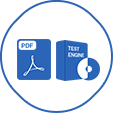Last Update 5 hours ago Total Questions : 120
The Oracle Planning 2025 Implementation Professional content is now fully updated, with all current exam questions added 5 hours ago. Deciding to include 1z0-1080-25 practice exam questions in your study plan goes far beyond basic test preparation.
You'll find that our 1z0-1080-25 exam questions frequently feature detailed scenarios and practical problem-solving exercises that directly mirror industry challenges. Engaging with these 1z0-1080-25 sample sets allows you to effectively manage your time and pace yourself, giving you the ability to finish any Oracle Planning 2025 Implementation Professional practice test comfortably within the allotted time.
Which two types of Groovy Rules are supported by Oracle?
You are preparing to design a report in Cloud EPM Planning using Report Designer. Which two statements are true about data sources in reports?
You want to copy data between two Planning instances. Which three tasks must you complete so you can copy the data?
You must assign a Planning user with a Cloud EPM predefined role that allows them to create and administer Planning or Planning Modules and service components. This role should also allow them to grant permissions to other users.
Which of the following predefined role must you assign this Planning user?
Which three types of revenue and expense assumptions drive data calculations in Projects?
Which statement is true about the Currency dimension for Modules and Custom application types?
Which two statements are true about using anchor and nonanchor dimensions with cell-level security?

